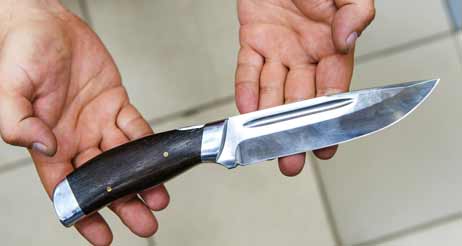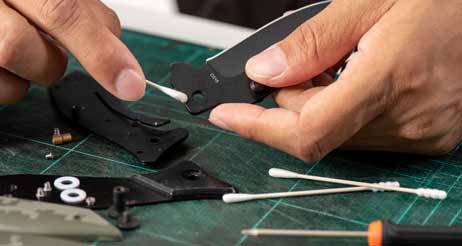The heel is the widest part of the cutting edge of the knife, located at the rear of the blade where it meets the handle. The extra thickness this heel makes this portion of the cutting edge ideal for chopping hard items like carrots, nuts, and even cracking chicken bones.
Knife Parts – The Bolster
The bolster (also known as the collar or shank) is the point where the blade meets the handle. All high quality knives will have a bolster. It is important the the bolster be a continuation of the heel. Some knives have a collar that may initially appear to be a bolster, but it is actually a separate piece of metal that is attached to the handle. These knives should be avoided as they are not as durable and will tend to come apart.
Knife Parts – The Handle

Rosewood is the classic material for knife handles. It is extremely hard and has no grain which makes it less likely to split and/or crack. Other handles of lesser quality woods may be impregnated with plastic to protect the handle from damage caused by the continuous exposure to water and soap. Knife handles may also be made entirely of either metal of plastic as some consider them to be more sanitary. It is important that all non-wooden handles be thoroughly cleaned to remove grease, which will adheres more closely to the plastic and metal than wood.
Regardless of the material, the handle should fit comfortably in your hand. since this will improve the ease and speed with which you are able to work. The handle should rest naturally across your palm and feel like an extension of your hand. Some knives are specially manufactured for left handed chefs.
Knife Parts – The Tang
No I’m not talking about the orange drink the astronauts took to the moon (for those of you old enough to remember the commercials). Although it is not visible in the image, the tang is the continuation of the blade which extends into the knife’s handle. The type of tang a knife contains is easily identified by looking at the spine side of the knife.
A full tang refers to a knife with a tang that extends the entire length of the handle. The spine of the blade should visibly continue through the center of the handle. Heavy work knives such as cleavers and chef’s knives require additinal strength and should always have full tangs.
A partial tang, as the name implies, does not run the entire length of the handle, so they are not as durable full tang knives. Partial tang knives are acceptable for less frequently used or lighter duty knives, such as paring knives, check my source.
A rat-tail tang is a hybrid of the full and partial tang. It is much thinner than the spine of the blade and is also encased within the handle so it is not visible on the top and bottom of the handle as the full tang is. Knives with rat-tail tangs are typically less durable, and are not appropriate for heavy or extended use.
Knife Parts – The Rivets

Rivets are the metal fasteners that are used to secure the handle to the tang. Make sure that all rivets are flush with the surface of the handle and are completely smooth. Uneven rivets may irritate and blister your hand, and are potential pockets where bacteria can grow.
